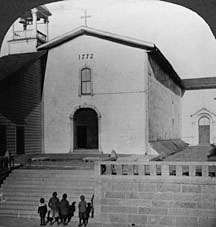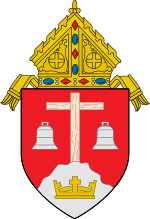Mission San Luis Obispo de Tolosa
Mission San Luis Obispo de Tolosa (Spanish: Misión San Luís Obispo de Tolosa) is a Spanish mission founded in 1772 by Father Junípero Serra in San Luis Obispo, California. Named after Saint Louis of Anjou, the bishop of Toulouse, the mission is the namesake of San Luis Obispo. Today, it offers tours of the beautiful church, gardens, school and small museum that holds a collection of its artifacts. Unlike other California missions, the San Luis Obispo Mission is open to the public every day of the year and is still a very popular parish for the town's Catholic community.
Misión San Luís Obispo de Tolosa in 2011. | |
 Location of Mission San Luis Obispo de Tolosa in California | |
| Location | 728 Monterey St. San Luis Obispo, California 93401 |
|---|---|
| Coordinates | 35°16′50″N 120°39′52″W |
| Name as founded | La Misión de San Luís Obispo de Tolosa [1] |
| English translation | The Mission of Saint Louis Bishop of Toulouse |
| Patron | Saint Louis of Anjou, Bishop of Toulouse, France |
| Nickname(s) | "Prince of the Missions" [2] "Mission in the Valley of Bears" [3] "The Accidental Mission" [4] |
| Founding date | September 1, 1772 [3] |
| Founding priest(s) | Father Presidente Junípero Serra [5] |
| Founding Order | Fifth |
| Military district | Third [6] |
| Native tribe(s) Spanish name(s) | Chumash Obispeño |
| Native place name(s) | Tilhini [7] |
| Baptisms | 2,644 [8] |
| Marriages | 763 [8] |
| Burials | 2,268 [8] |
| Governing body | Roman Catholic Diocese of Monterey |
| Current use | Parish Church / Museum |
| Reference no. | 325[9] |
| Website | |
| http://www.missionsanluisobispo.org | |
The Mission of San Luis Obispo is unusual in its design, in that its combination of belfry and vestibule are found nowhere else among the California missions. Like other churches, the main nave is short and narrow, but at the San Luis Obispo Mission, there is a secondary nave of almost equal size situated to the right of the altar, making it the only L-shaped mission church in California.
History
In 1769, Gaspar de Portola traveled through California on his way to the Bay of Monterey and discovered the San Luis Obispo area.[10] Expedition diarist and Franciscan missionary Juan Crespí wrote that the soldiers called the place "llano de los osos," or the "level of the bears." Since then, mistranslations of the Crespi's diary have called this area "la canada de los osos" (the canyon of the bears) which has been further mistranslated as the "valley of the bears." Portola followed the same route the following year, on his way to establish the Presidio of Monterey. Missionary president Junípero Serra, traveling by sea, met the Portola party there and founded San Carlos Borremeo, in Monterey, which was moved to Carmel the following year.[11]
When food supplies started to dwindle at the mission, Serra remembered the stories of the "valley of the bears." He decided to send a hunting expedition to San Luis Obispo to help feed the Spanish and neophytes (natives that converted to Christianity) in Monterey. The huge success of the hunting expedition caused Junípero Serra to consider building a mission in that area. Upon further investigation, he was convinced that San Luis Obispo would be a perfect site for a mission, based on its surplus of natural resources, good weather and the Chumash, a local, friendly Native American tribe who could help provide labor. The mission became the fifth in the mission chain founded by Father Junípero Serra.[12]
Father Serra sent an expedition down south to San Luis Obispo to start building the mission, and on September 1, 1772, a cross was erected near San Luis Obispo Creek and Serra celebrated the first mass. However, following the first mass, Father Junípero Serra left the responsibility of construction to Father Jose Cavaller. Father Cavaller, five soldiers and two neophytes began building what is now Mission San Luis Obispo de Tolosa.[13] Father Cavaller received help in the building of the mission from the Chumash, who constructed palisades, which would serve as temporary buildings for the mission. However, due to several Native American tribes which were determined to get rid of European settlers, they set these buildings ablaze. Because of this, Father Cavaller was forced to rebuild the buildings using adobe and tile structures.[14]

Beginning in 1794 Mission San Luis Obispo went through extensive building operations.[14] Buildings to accommodate the nearby Native Americans and many improvements to the mission, including storerooms, residences for single women, soldiers barracks and mills were added.[15] The renovation was finally finished after completion of the quadrangle in 1819, and celebrated a year later by the arrival of two mission bells from Lima, Peru.[16] The arrival of the bells marked the end of improvements made to Mission San Luis Obispo de Tolosa for many years.[12] In 1830 Father Luis Gil y Taboada took over the mission, but he died three years later. Then in 1842, the death of Father Ramon Abella marked the last Franciscan at the mission.[12]
In 1845, Governor Pío Pico declared the mission buildings for sale and he sold everything except the church for a total of $510. John C. Frémont and his "California Battalion" used the mission as a base of operations during their war with Mexico in 1846 (see Bear Flag Revolt). The mission fell to ruins during the period of secularization and the priests who were left would rent out rooms to help support the mission. The Mission San Luís Obispo de Tolosa became the first courthouse and jail in San Luis Obispo County, California. In 1850, when California became a part of the United States, the first California bishop, Joseph Alemany, petitioned the Government to return some of the mission lands back to the Church.[17] Since then, it has undergone major civic, political and structural changes, but real restoration did not begin until 1933.[18] The mission is still the center of the busy downtown area, and functions as a Roman Catholic parish church for the City of San Luis Obispo in the Diocese of Monterey. In 1970 the Mission was recognized as the center of the City of San Luis Obispo, with the dedication of Mission Plaza.[12]
Spanish Origin
In 1602, the Spanish began to show interest in California and sent Sebastián Vizcaíno, a pearl fisher, to explore the area. Vizcaino traveled the coast naming many of the cities that are important to the California coast today such as San Diego, Santa Barbara and Monterey. Spain finally chose to create Vizcaino's suggested chain of missions when it was proven that California was indeed part of the continent. The goal of creating the chain was given to the Franciscan Order. While Spain had economic motives for establishing a stronghold in California, the Franciscan order of the Catholic Church also had religious motives.[19] With these factors in mind the missions were created in order to control the coast so that the ships from Spain would remain safe as well as bring the Natives to the Catholic faith. Re-education became the method for reaching Spain's religious and economic goals as they strived to convert the Native Americans to Catholicism as well as make them loyal Spanish subjects.
See also
- Spanish missions in California
- Mission San Luis Obispo – a Mission Buenaventura Class fleet oiler built during World War II.
- City of San Luis Obispo Historic Resources
Notes
- Leffingwell, p. 85
- Schulte-Peevers, p. 682
- Yenne, p. 56
- Ruscin, p. 53
- Ruscin, p. 196
- Forbes, p. 202
- Ruscin, p. 195
- Krell, p. 315: as of December 31, 1832; information adapted from Engelhardt's Missions and Missionaries of California.
- "Mission San Luis Obispo de Tolosa". Office of Historic Preservation, California State Parks.
- "Visit". Mission San Luis Obispo de Toulosa. Retrieved 2018-10-23.
- "Visit". Mission San Luis Obispo de Toulosa. Retrieved 2018-10-23.
- "Mission History". Archived from the original on 25 July 2011.
- "Visit". Mission San Luis Obispo de Toulosa. Retrieved 2018-10-23.
- "San Luis Obispo de Tolosa". Archived from the original on 28 January 2010.
- "Visit". Mission San Luis Obispo de Toulosa. Retrieved 2018-10-23.
- "Mission San Luis Obispo de Tolosa". Archived from the original on 21 January 2010.
- "Visit". Mission San Luis Obispo de Toulosa. Retrieved 2018-10-23.
- "Visit". Mission San Luis Obispo de Toulosa. Retrieved 2018-10-23.
- "Mision San Carlos, Carmel". Archived from the original on 27 October 2009.
References
- Forbes, Alexander (1839). California: A History of Upper and Lower California. Smith, Elder and Co., Cornhill, London.
- Jones, Terry L. and Kathryn A. Klar (eds.) (2007). California Prehistory: Colonization, Culture, and Complexity. Altimira Press, Landham, Maryland. ISBN 0-7591-0872-2.CS1 maint: extra text: authors list (link)
- Krell, Dorothy (ed.) (1979). The California Missions: A Pictorial History. Sunset Publishing Corporation, Menlo Park, California. ISBN 0-376-05172-8.CS1 maint: extra text: authors list (link)
- Leffingwell, Randy (2005). California Missions and Presidios: The History & Beauty of the Spanish Missions. Voyageur Press, Inc., Stillwater, Minnesota. ISBN 0-89658-492-5.
- Paddison, Joshua (ed.) (1999). A World Transformed: Firsthand Accounts of California Before the Gold Rush. Heyday Books, Berkeley, California. ISBN 1-890771-13-9.CS1 maint: extra text: authors list (link)
- Ruscin, Terry (1999). Mission Memoirs. Sunbelt Publications, San Diego, California. ISBN 0-932653-30-8.
- Schulte-Peevers, Andrea (1996). California. Lonely Planet Publications, Oakland, California. ISBN 1-74059-951-9.
- Yenne, Bill (2004). The Missions of California. Advantage Publishers Group, San Diego, California. ISBN 1-59223-319-8.
- Mission Tour
- Chumash Indians
- Chumash History
- Spanish Missions
External links
| Wikimedia Commons has media related to Mission San Luis Obispo de Tolosa. |
- Mission San Luis Obispo - official site
- Elevation & Site Layout sketches of the Mission proper
- Early photographs, sketches, land surveys of Mission San Luis Obispo de Tolosa, via Calisphere, California Digital Library
- Howser, Huell (December 8, 2000). "California Missions (104)". California Missions. Chapman University Huell Howser Archive.
